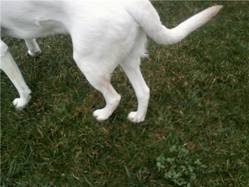Hip Dysplasia in Dogs
What is Hip Dysplasia?
Hip dysplasia is a malformation of the hip socket and is common among medium to large dog breeds. With a normal hip, the thigh bone is connected to the pelvis at the hip joint. The femur head fits into the socket of the hip snuggly and comfortably. A dysplastic hip’s femur is loosely or partially fit into the socket. Severe forms of hip dysplasia lead to painful and sometimes crippling arthritis.
 Dogs will stand with their hind legs close together to help compensate for hip dysplasia.Canine hip dysplasia is known to be both a genetic and environmentally caused disease, and onset symptoms generally occur by the time a dog is 18 months old. Environmental factors that may cause hip dysplasia include being overweight, overexertion of the hip, and an injury such as ligament tear at a young age.
Dogs will stand with their hind legs close together to help compensate for hip dysplasia.Canine hip dysplasia is known to be both a genetic and environmentally caused disease, and onset symptoms generally occur by the time a dog is 18 months old. Environmental factors that may cause hip dysplasia include being overweight, overexertion of the hip, and an injury such as ligament tear at a young age.
Symptoms of Hip Dysplasia in Dogs
Symptoms can range from mild discomfort to crippling arthritis.
- Stiffness or soreness after resting
- Unwillingness to jump, stand on hind legs, or climb stairs
- Lameness and pain
- Unwillingness to exercise
- Dislocation of the hip joint
- Decreased muscle mass in the hip area
- “Bunny-hopping” or other abnormal stance while walking, standing or running
Canine Hip Dysplasia Care
There is no “cure” for hip dysplasia, but steps can be taken to alleviate the symptoms and help your dog live a pain free, active life.
- Weight Management is perhaps the most important thing you can do for your pet. Many dogs require no other treatment for their arthritis once they have reached a normal weight range. However, many dogs need more than just weight management.
- Proper Exercise will help to stimulate cartilage growth and can help reduce degeneration. Vigorous exercises may cause more damage, so you may want to stick with moderate exercise such as regular long walks and short sessions of fetching games.
- Pay Attention to Symptoms. You may find that your companion tires faster during long walks. You may want to decrease the distance or take short standing breaks during walks.
- Anti Inflammatory Medications will decrease your dog’s pain. Non-steroidal Anti-Inflammatory Drugs (NSAIDs) and Cox-2 Inhibitors are commonly prescribed, but have been shown to be related to cardiovascular issues including bleeding.
- Surgery may be the best option in extreme cases. There are many different types of surgeries, but most involve removing the femur and either reshaping it or repositioning the hip socket. Hip replacement completely replaces the malformed joint and has a very high success rate in severe hip dysplasia cases.
Talk to your veterinarian about the severity of your dog’s hip dysplasia and ask about the treatment options. If treatment starts early, surgery can be avoided.

 Dogs will stand with their hind legs close together to help compensate for hip dysplasia.Canine hip dysplasia is known to be both a genetic and environmentally caused disease, and onset symptoms generally occur by the time a dog is 18 months old. Environmental factors that may cause hip dysplasia include being overweight, overexertion of the hip, and an injury such as ligament tear at a young age.
Dogs will stand with their hind legs close together to help compensate for hip dysplasia.Canine hip dysplasia is known to be both a genetic and environmentally caused disease, and onset symptoms generally occur by the time a dog is 18 months old. Environmental factors that may cause hip dysplasia include being overweight, overexertion of the hip, and an injury such as ligament tear at a young age.